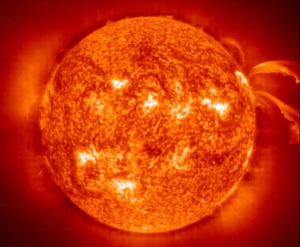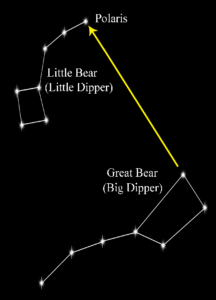Science > Physics > Astronomical Physics > Stars
The stars, the planets, the moon and many other objects in the sky are called celestial or heavenly bodies. The universe includes everything that exists. A cluster of stars is called Galaxy. A galaxy contains billions of stars. Galaxies exist in different shapes. Our galaxy is called Milky Way (Akashganga). It consists of 100 billion stars including our sun. There are millions of galaxies like the Milky Way. The Milky Way has between 100 to 400 billion stars. The stars forming a group that has a recognizable shape is called a constellation. The shape of the constellation remains the same.
The distance between the two celestial objects is very large. Hence it cannot be measured by using our practical terrestrial unit kilometre. The distance between celestial bodies is measured in a unit called a light-year. Though it contains the word year, it is not the unit of time. It is the unit of distance. Light moves at a velocity of about 300,000 kilometres per second. The distance that light can travel in one year is called the light year. So in one year, light can travel about 10 trillion km. More precisely, one light-year is equal to 9,500,000,000,000 kilometers.
Characteristics of Stars:
- A star is a huge sphere of glowing gases. Star emits light of their own. The colour of a star depends on the temperature of the surface of the star. Blue stars are the hottest with the surface temperature of 28000 °C. Yellow white star (Our Sun) have the surface temperature of 6000 °C. Red stars have the surface temperature of 3000 °C.
- The Sun is the nearest star to the Earth. The next nearest star to the Earth is Alpha Centauri which is at a distance of 40,000,000,000,000 km (40 billion km) from the Earth.
- They are present in the sky during the daytime also. However, they are not visible then because of the bright sunlight.
- The Sun is a quiet smaller star than other stars but these stars are millions of times farther away than the sun to the Earth. Therefore the stars appear to us like points.
- They appear to move from the east to the west. Actually, the Earth rotates about its axis from the west to the east, hence we see the apparent movement of the stars from the east to the west.
- Polestar appears to be stationary throughout because it lies almost along the axis of rotation of the Earth.
- They appear to be permanent because the physical characteristics like brightness, temperature, colour and size change very slowly with time as compared to our lifespan. Actually, stars are slowly dying. It takes millions of years for noticeable change to occur in a star while the average lifespan of a human being is 70 years. Hence stars appear to be permanent to us even though they are born, grow and then die.
- They are very far away from the Earth and appear as dots or points. The point position of the stars vibrate due to disturbances by air currents and hence they appear to twinkle.
- The distances between stars are very large. To measure such large distances, the unit kilometre is very small. Hence astronomical unit lightyear is used to measure the distances between the stars.
Sun:

The Sun is the nearest star to the Earth. The sun is nearly 150,000,000 km (150 million km) away from the Earth. The diameter of the sun is about 1,392,000 km. The Sun is so big that it can accommodate 1.3 million Earth in it. The temperature on the surface of the Sun is about 6000 °C while the temperature at the centre of the Sun is about 1,400,000 °C.
Sun emits a huge amount of energy continuously which is produced due to the nuclear fusion reaction. In this process, four nuclei of hydrogen combine to form one nucleus of helium. During this process, a large amount of energy is produced. The sun is the source of almost all energy on the Earth.
Sun is a star because it has its own source of energy. It continuously emits a huge amount of energy in the form of heat and light. It has a life period. It was born 5 billion years ago and is expected to glow for another 5 billion years.
Light takes 8 minutes to travel from the Sun to the Earth, hence the distance between the sun and the Earth is about 8 light minutes.
The distance of the nearest star Alpha Centauri from the Earth is 4.3 light-years.
Pole Star:
Polestar can be located with the help of the constellation ‘The Great Bear’. Imagine a straight line passing through the stars at the end of the constellation ‘The Great Bear’ as shown. Extend this imaginary line towards the north (about 5 times the distance between the two stars). This line will lead to a star which is not bright. This is the Polestar.

The pole star has a unique importance. The Pole star lies almost along the axis of rotation of the Earth. Hence it appears to be practically stationary from the northern sphere. Thus we can locate the North direction using Pole star at night. Thus other directions can be located using Pole star.